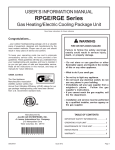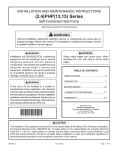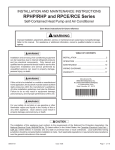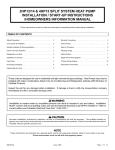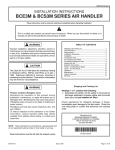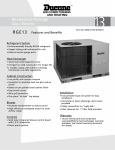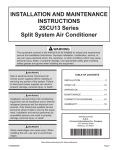Download Allied Air Enterprises (2,4)PCE(13,15) SERIES User's Manual
Transcript
INSTALLATION AND MAINTENANCE INSTRUCTIONS (2,4)PCE(13,15) SERIES Electric Cooling Package Unit Save these instructions for future reference WARNING Improper installation, adjustment, alteration, service, or maintenance can cause injury or property damage. Refer to this manual. For assistance or additional information, consult a qualified installer or service agency. WARNING TABLE OF CONTENTS Installation and servicing of air conditioning equipment can be hazardous due to internal refrigerant pressure and live electrical components. Only trained and qualified service personnel should install or service this equipment. Installation and service performed by unqualified persons can result in property damage, personal injury, or death. INSTALLATION ...................................... 2 OPERATION .......................................... 7 MAINTENANCE ..................................... 9 CONNECTION DIAGRAMS ................. 10 WARRANTY ......................................... 12 WARNING If this unit is to be installed in a mobile or manufactured home application, the ductwork must be sized to achieve static pressures within the manufacturer’s guidelines. All other installation guidelines must also be followed. Failure to do so may result in equipment damage, personal injury, and improper performance of the unit. Manufactured By Allied Air Enterprises Inc. A Lennox International Inc. Company 215 Metropolitan Drive West Columbia, SC 29170 WARNING Sharp metal edges can cause injury. When installing the unit, use care to avoid sharp edges. *506252-01* CAUTION The installation of this appliance must conform to the requirements of the National Fire Protection Association; the National Electrical Code, ANSI/NFPA No. 70 (latest edition) in the United States; the Canadian Electrical Code Part 1, CSA 22.1 (latest edition) in Canada; and any state or provincial laws or local ordinances. Local authorities having jurisdiction should be consulted before installation is made. Such applicable regulations or requirements take precedence over the general instructions in this manual. 506252-01 Issue 0902 Page 1 of 13 INSTALLATION These instructions, and any instructions packaged with mating components and/or accessories, should be carefully read prior to beginning installation. Note particularly any CAUTIONS or WARNINGS in these instructions and all labels on the units. These instructions are intended as a general guide only, for use by qualified personnel and do not supersede any national or local codes in any way. Compliance with all local, state, provincial, or national codes pertaining to this type of equipment should be determined prior to installation. The unit must not be installed with any ductwork in the outdoor air stream. The outdoor fan is not designed to operate against any additional static pressure. Location The unit is designed to be located outdoors with sufficient clearance for free entrance to the air inlet and discharge air openings. The location must also allow for adequate service access. These instructions explain the recommended method of installation of the PCE electric cooling unit and associated electrical wiring. The unit must be installed on a solid foundation that will not settle or shift. Adequate structural support must be provided. Maintain minimum clearances as shown in Table 1 and install the unit in level position. Isolate the base from the building structure to avoid possible transmission of sound or vibration into the conditioned space. The PCE unit is designed and approved for use as a selfcontained air-to-air air conditioning system. Minimum Clearance Requirements To Com bust ible Mat er ial Fo r Se r vi c e Fo r Pr o p e r Op e r a t i o n Front 0" 48" 3" Rear 0" 24" 3" Condenser End 0" 24" 3" Blower End 0" 30" 0" Top 0" 36" 36" The unit is factory equipped with a transformer and blower control for applications without auxiliary heat. An electric heat accessory kit (PHK) can be ordered for field installation of additional heat where required. IMPORTANT: The 15 SEER models have been designed and manufactured to meet ENERGY STAR criteria for energy efficiency. However, proper refrigerant charge and proper air flow are critical to achieve rated capacity and efficiency. Installation of this product should follow the manufacturer’s refrigerant charging and air flow instructions. Failure to confirm proper charge and airflow may reduce energy efficiency and shorten equipment life. Inspection of Shipment Upon receipt of equipment, carefully inspect it for possible shipping damage. If damage is found, it should be noted on the carrier’s freight bill. Take special care to examine the unit inside the carton if the carton is damaged. File a claim with the transportation company. Table 1 If any damages are discovered and reported to the carrier DO NOT INSTALL THE UNIT, as claim may be denied. Avoid placing the unit near quiet areas such as sleeping quarters or study rooms. Normal operating sound levels may be objectionable if the unit is placed near certain rooms. Check the unit rating plate to confirm specifications are as ordered. Do not permit overhanging structures or shrubs to obstruct condenser air discharge inlet or outlet. Limitations The unit should be installed in accordance with all national and local safety codes. For improved start-up performance, the indoor coil should be washed with suitable detergent to remove any residue from manufacturing processes. Limitations of the unit and appropriate accessories must also be observed. Exercise care when moving the unit. Do not remove any packaging until the unit is near the place of installation. An accessory lift kit can be purchased to aid in rigging (see Figure 1). Spreaders whose length exceed the largest Page 2 of 13 Issue 0902 506252-01 Clearances All units require certain clearances for proper operation and service. Refer to Table 1 for the minimum clearances to combustibles as well as minimum clearances necessary for servicing and proper unit operation. Using Accessory Lift Kit Lifting Bracket Accessory Sheet Metal Screw Spreaders (Field Supplied) In the U.S., units may be installed on combustible floors made from wood or class A, B, or C roof covering material. In Canada, units may be installed on combustible floors. Service Access Access to all serviceable components is provided by four removable panels: filter compartment, blower compartment, heater compartment, and top panel. To avoid possible damage to unit panels from lifting clevis, place packing material between clevis and panels before lifting unit. Condensate Drain The PCE package unit is equipped with a 3/4" FPT coupling for condensate line connection. Plumbing must conform to local codes. Use a sealing compound on male pipe threads. Figure 1 dimension across the unit must be used across the top of the unit. Recommended spreader length: 3 ton and smaller package units – 44", 3.5 ton and larger units – 54". Units may also be moved or lifted with a forklift while still in the factory-supplied packaging. The lengths of the forks of the forklift must be a minimum of 42". The condensate drain line must be properly trapped and routed to a suitable drain. See Figure 3 for proper drain arrangement. The drain line must pitch to an open drain or pump to prevent clogging of the line. Seal around the drain connection with suitable material to prevent air leakage into the return air system. Ductwork Ductwork should be designed and sized according to the CAUTION Before lifting a unit, make sure that the weight is distributed equally on the cables so that it will lift evenly. Typical Condensate Drain Connection Unit Drain Connection Roof Curb Installation If a roof curb is used, follow the manufacturer’s Installation Instructions and be sure that all required clearances are observed (see following Clearances section). 1.00" Min. 12.00" Max. 3.00" Min. Positive Liquid Seal Required Roof Curb Assembly Figure 3 methods in Manual Q of the Air Conditioning Contractors of America (ACCA). A closed return duct system shall be used. This shall not preclude use of economizers or outdoor fresh air intake. It is recommended that supply and return duct connections at the unit be made with flexible joints. Figure 2 506252-01 The supply and return air duct systems should be designed for the CFM and static requirements of the job. They should Issue 0902 Page 3 of 13 not be sized by matching the dimensions of the duct connections on the unit. Minimum Required Surface Area for Disposable Filters Outdoor ductwork must be insulated and waterproofed. Equipment is shipped for side ductwork connection. The unit can be converted to bottom ductwork connection by removing the duct covers located over the bottom duct openings and placing these covers over the side duct openings (see Figure 4). To remove the bottom duct cover over supply opening: 1. Remove screw on cover nearest side opening. N o m i n a l Co o l i n g Fi l t e r Ar e a (s q . f t .) 24,000 2.67 30,000 3.33 36,000 4.00 42,000 4.67 48,000 5.33 60,000 6.67 2. Lift end of cover slightly and push to slide back screw/ pin free from duct flange. Table 2 3. Slide duct cover out the side duct opening. Electrical Wiring Removing Bottom Duct Covers WARNING 2 Line voltage is present at all components when unit is not in operation on units with single pole contactors. Disconnect all remote electric power supplies before opening access panel. Unit may have multiple power supplies. Failure to disconnect all power supplies could result in personal injury or death. 1 1. Remove screw and lift. 2. Slide cover to free back pin. Base Figure 4 All wiring should be done in accordance with the National Electrical Code, ANSI/NFPA No. 70 (latest edition); Canadian Electrical Code Part 1, CSA C22.1 (latest edition); or local codes where they prevail. Use wiring with a temperature limitation of 75°C minimum. Run the electric power supply through a fused disconnect switch to the connection box of the unit and connect as shown in the wiring diagram located on the inside of the control access panel. CAUTION When fastening ductwork to side duct flanges on unit, insert screws through duct flanges only; do not insert screws through casing. If using bottom duct work, do not use screws to secure ductwork to bottom duct opening under drain pan side. Using screws to secure bottom duct may damage drain pan. Filters Air filters are to be used with this heating/cooling unit. Filters are not factory supplied in the unit. However, a filter frame accessory is available from the manufacturer that allows filters to be installed within the unit. If the filter frame accessory is not used, a filter must be installed in the duct work by the installer. Filters must always be installed ahead of the evaporator coil and must be kept clean or replaced. Dirty filters will reduce the airflow of the unit. Filters should be sized in accordance with Table 2. Page 4 of 13 CAUTION When connecting electrical power and control wiring to the unit, waterproof type connectors must be used so that water or moisture cannot be drawn into the unit during normal operation. Issue 0902 506252-01 WARNING Electrical Access Unit must be grounded in accordance with national and local codes. Failure to ground unit properly can result in personal injury or death. Heater Power Entry Thermostat Entry Power supply to the unit must comply with all applicable codes and the National Electical Code (NEC) or Canadian Electrical Code (CEC). A fused disconnect switch should be field provided for the unit. The switch must be separate from all other circuits. Line Voltage Entry Figure 5 If any of the wire supplied with the unit must be replaced, replacement wire must be of the type shown on the wiring diagram. Electrical wiring must be sized to carry minimum circuit ampacity marked on the unit. Use copper conductors only. Each unit must be wired with a separate branch circuit and be properly fused. Thermostat The room thermostat should be located on an inside wall where it will not be subject to drafts, sun exposure, or heat from electrical fixtures or appliances. Follow the manufacturer’s instructions enclosed with thermostat for general installation procedure. Color-coded insulated wires (#18 AWG) should be used to connect thermostat to unit. Four wires are required for cooling. Typical Wiring Connections THERMOSTAT OUTDOOR UNIT THERMOSTAT OUTDOOR UNIT R R R R C C C C Y Y Y1 ECONOMIZER NOT INSTALLED BLUE YELLOW W1 W ECONOMIZER YELLOW Y W2 G G W1 W W2 G CAUTION Do not connect C connections except when required by the indoor thermostat. Refer to the thermostat installation instructions. GREEN G BLACK Y2 L2 L1 L3 L2 L1 GROUND SCREW POWER WIRING 208/230-1-60 (75°C MIN. WIRE) POWER WIRING 24V CONTROL WIRING (NEC CLASS 2) * W1, W2 CAN BE USED TO STAGE ELECTRIC HEAT ACCESSORY ON 15 & 20 KW MODELS. * 5 & 10 KW HEATER ACCESSORY FUNCTION OFF W1 ONLY. TYPICAL WIRING CONNECTION 1 PHASE CAUTION Do not connect C connections except when required by the indoor thermostat. Refer to the thermostat installation instructions. GROUND SCREW POWER WIRING 200/230-3-60, 460/575-3-60 (75°C MIN. WIRE) POWER WIRING 24V CONTROL WIRING (NEC CLASS 2) * W1, W2 CAN BE USED TO STAGE ELECTRIC HEAT ACCESSORY ON 15 & 20 KW MODELS. * 10 KW HEATER ACCESSORY FUNCTION OFF W1 ONLY. TYPICAL WIRING CONNECTION 3 PHASE Figure 6 506252-01 Issue 0902 Page 5 of 13 Compressor Units are shipped with compressor mountings factoryadjusted and ready for operation. Caution: Do not loosen compressor mounting bolts. Heater Kit Accessory Installation Heater Kit Accessory (if used) The unit is fully equipped for cooling operation without auxiliary heat. A heater kit accessory may also be used. Heater Blockoff To install the heater kit accessory (see Figure 7): Heater Compartment Access Panel 1. Disconnect the power and remove the heater compartment access panel. 2. Disconnect the plug separating the high voltage wire harness. Remove the high voltage wire harness plug and discard. Heater Kit Figure 7 3. Remove the heater blockoff by removing the four screws holding it in place. 4. Insert the heater into the control panel and fasten in the same mounting holes. 5. Plug the heater wiring harness into the wire harness on the control assembly. Field wiring of the auxiliary heater is separate from the unit power supply. Wire the power supply wiring for the heater to the appropriate connections on the heater kit. 3. Insofar as is practical, close all building doors and windows between the space in which the appliances remaining connected to the common venting system are located and other spaces in the building. Turn on clothes dryers and any appliance not connected to the common venting system. Turn on exhaust fans, such as range hoods and bathroom exhausts, so they will operate at maximum speed. Do not operate a summer exhaust fan. Close fireplace dampers. 6. Replace the heater compartment access panel and reconnect the power. 4. Following the lighting instructions, place the unit being inspected in operation. Adjust the thermostat so the appliance will operate continuously. Removal of Unit from Common Venting System When an existing indoor furnace is removed from a common venting system serving other appliances, the venting system is likely to be too large to properly vent the remaining attached appliances. The following test should be conducted with each appliance while the other appliances connected to the common venting system are not in operation. 5. Test for spillage at the draft control relief opening after 5 minutes of main burner operation. Use the flame of a match or candle. 1. Seal any unused openings in the common venting system. 2. Visually inspect the venting system for proper size and horizontal pitch and determine there is no blockage or restriction, leakage, corrosion, or other deficiencies which could cause an unsafe condition. Page 6 of 13 6. Follow the preceding steps for each appliance connected to the common venting system. 7. After it has been determined that each appliance remaining connected to the common venting system properly vents when tested as outlined above, return doors, windows, exhaust fans, fireplace dampers, and any other fuel burning appliance to their previous condition of use. 8. If improper venting is observed during any of the above tests, the common venting system must be corrected. See National Fuel Gas Code, ANSI Z223.1 (latest edition) or CAN/CGA B149.1 & .2 Canadian Installation Codes to correct improper operation of common venting system. Issue 0902 506252-01 OPERATION Sequence of Operation Cooling Upon cooling demand, the thermostat closes circuit R and Y. Closing R and Y closes the unit contactor, starting the compressor and outdoor fan. The thermostat automatically closes R to G circuit which also brings on the indoor blower at the same time. Upon satisfying cooling demand, the thermostat will open the above circuits and open the main contactor, stopping the compressor and outdoor fan. If the unit is equipped with a delay timer, the blower will continue to operate for 90 seconds which improves system efficiency. Circulating Air Blower Depending on the package unit model, the blower motor will be either a multi-tap PSC motor or a variable speed motor. PSC Motor The circulating air blower is controlled by a timing circuit in the blower control. Timings are not adjustable. There is no blower “on” delay after a call for heating or cooling. Blower “off” delay is 90 seconds after the thermostat is satisfied. Variable Speed Motor Units equipped with a variable speed circulation air blower motor will deliver a constant airflow within a wide range of external static pressures. Other features of this variable speed motor include: Soft Start/Stop – The variable speed motor will slowly ramp up to normal operating speed. This minimizes noise and increases comfort by eliminating the initial blasts of air encountered with standard motors. At the end of a cooling or heating cycle, the motor will slowly ramp down. Circulation Airflow Adjustments – The controls include a variable speed motor interface board. The ADJUST tap can be used to raise (+) or lower (–) the airflow by 15%. Heating and Cooling Airflows – The units are factory set for the correct heating and cooling airflows. However, airflow changes can be made by moving the position of the HEAT and COOL taps (see Table 4). Continuous Blower – The comfort level of the living space can be enhanced when using this feature by allowing continuous circulation of air between calls for cooling or heating. The continuous circulation of air occurs at half the full cooling airflow rate. To use this feature, place the thermostat fan switch into the ON position. Cooling Airflow Ramp Up – At the beginning of a call for cooling, the blower will run at 80% of full airflow for 7.5 minutes. This improves the system’s moisture removal and saves blower power during cooling start. Reduced Airflow Operation (Dehumidification) – For situations where humidity control is an issue, the variable speed motor can be connected to operate at a 25% reduction in the normal airflow rate. The variable speed motor interface board provides for connection of a humidistat on the HUM terminal. When a humidistat is connected, the dehumidifier resistor on the interface must be cut. The humidistat should be wired to open during high humidity, which will reduce blower airflow. Adjusting Airflow (Variable Speed Motor Equipped Units Only) Model Nom inal Co o l i n g kB T U Heat ing Si z e kW Mot or HP AD J U ST H EAT CO O L Se t t i n g Se t t i n g Se t t i n g CFM A CFM B CFM C CFM D 24 5-10 1/3 NORM B B 1000 80 0 600 900 30 5-10 1/3 NORM A A 1000 800 600 900 36 5-15 1/2 NORM A A 1200 1000 800 110 0 42 5-20 3/4 NORM C C 1800 1600 1400 1200 48 5-20 3/4 NORM B B 1800 1600 1400 1200 60 5-20 3/4 NORM A A 1800 1600 1400 1200 ADJUST, HEAT, and COOL Taps and Dehumidify Resistor on Interface Board ADJUST NORM (+) (–) TEST HEAT COOL A B C D A B C D D1 DEHUMIDIFY CUT TO ENABLE Table 3 506252-01 Issue 0902 Page 7 of 13 Cooling System Performance For maximum performance of the cooling system, operating temperatures and pressure should be checked. Superheat should be determined at Standard ARI test conditions of 82°F outdoor and 80°F indoor dry bulb/67°F wet bulb. If superheat measured deviates from values found in Table 4, refrigerant charge should be adjusted accordingly for maximum performance. Suction Superheat Si z e Su c t i o n Su p e r h e a t @ ARI Co n d i t i o n s 8 2 ° O D - 8 0 ° I D D B / 6 7° I D WB R2 2 4 10 A 24 22° 15° 30 20° 15° 36 20 ° 12° 42 20° 12° 48, 60 20° 10° Table 4 Page 8 of 13 Issue 0902 506252-01 MAINTENANCE Owner Record WARNING Model # _________________________________ ELECTRICAL SHOCK, FIRE, OR EXPLOSION HAZARD Serial # _________________________________ Installation Date ___________________________ Failure to follow the safety warnings exactly could result in dangerous operation, serious injury, death, or property damage. Installed by: Dealer __________________________________ Improper servicing could result in dangerous operation, serious injury, death, or property damage. Address _________________________________ Telephone # ______________________________ License # ________________________________ • Before servicing, disconnect all electrical power to unit. • When servicing controls, label all wires prior to disconnecting. Reconnect wires correctly. • Verify proper operation after servicing. At the beginning of each heating season, system should be checked as follows by a qualified service technician: Periodic inspection and maintenance normally consists of changing or cleaning the filters and cleaning the outdoor coil. On occasion, other components may also require cleaning. Filters Filters should be checked at least every 6 weeks. Disposable filters should be replaced when dirty, and cleanable filters should be cleaned regularly. It is important to keep the air filters clean, as dirty filters can restrict airflow and the blower motor depends upon sufficient air flowing across and through it to keep from overheating. Motors Indoor and outdoor fan and vent motors are permanently lubricated and require no maintenance. Outdoor Coil Dirt and debris should not be allowed to accumulate on the outdoor coil surface or other parts in the air circuit. Cleaning should be as often as necessary to keep coil clean. Use a brush, vacuum cleaner attachment, or other suitable means. If water is used to clean the coil, be sure the power to unit is shut off prior to cleaning. Care should be used when cleaning the coil so that the coil fins are not damaged. Do not permit the hot condenser air discharge to be obstructed by overhanging structures or shrubs. 506252-01 Issue 0902 Page 9 of 13 Figure 8 HIGH 60 L2 T1 C COMPRESSOR 208/230V-1-60 B1 MED 48 R L2 T2 S BLK PUR K1-2 COMPRESSOR CONTACTOR RED H C DUAL CAPACITOR C12 F P-1 P-2 BRN LOW 42 BLK K1-1 COMPRESSOR CONTACTOR HIGH 36 L1 MED 30 L1 LOW 24 C NO CONDENSER FAN MOTOR B4 B3 P-3 T1 RED GRN A15 BLOWER CONTROL G C FUSE R RED BLU K1 CONTACTOR Connection Diagram Single Phase – PSC Motor P/N 48396-001 INDOOR BLOWER MOTOR M L C CAPACITOR C4 H RED A15 BLOWER CONTROL NC 5, 7.5, & 10kW heater accessories function off W1 only. YEL P-4 S4 HIGH PRESSURE SWITCH (IF USED) YEL L MH C MOTOR SPEED TAPS YEL S1 G R Y THERMOSTAT C BLU W1 & W2 can be used to stage electric heat accessory on 15 & 20kW models. YEL Line voltage field installed. RED WARNING - Electric shock hazard. Unit must be grounded in accordance with national and local codes. SEE CHART FOR WIRING BLK BLK BLK (BLK) 208V Cooling Input YEL NOTE - If any of the original wire is replaced, the same size and type wire must be used. Use copper conductor only, min. 75°C wire. WHT BLK 240V TRANSFORMER YEL Factory Shipped Settings RED 24V BLU Unit XFMR-C XFMR-R BLU Issue 0902 BLU GRN BLOWER SPEED CHART BLU W1 P-5 P-6 WHT Page 10 of 13 506252-01 Figure 9 506252-01 Issue 0902 Page 11 of 13 NORM NORM NORM NORM NORM NORM 30 36 42 48 60 ADJUST A B C A A B HEAT CONDENSER FAN MOTOR A B C A A B COOL Factory Shipped Settings 24 Unit BLOWER SPEED CHART Connection Diagram Single Phase – Variable Speed Motor P/N 48397-001 5, 7.5, & 10kW heater accessories function off W1 only. W1 & W2 can be used to stage electric heat accessory on 15 & 20kW models. Line voltage field installed. WARNING - Electric shock hazard. Unit must be grounded in accordance with national and local codes. NOTE - If any of the original wire is replaced, the same size and type wire must be used. Use copper conductor only, min. 75°C wire. DIAGNOSTIC MODULE ALLIED AIR ENTERPRISES EQUIPMENT LIMITED WARRANTY APPLIES IN U.S.A. AND CANADA ONLY FAILURE TO MAINTAIN YOUR EQUIPMENT WILL VOID THIS WARRANTY COVERED EQUIPMENT The following Allied Air Enterprises heating and cooling equipment is covered by the Limited Warranty, Condensing Units: 2SCU13, 4SCU13, 4SCU14, 4SCU16, 4SCU18, 2AC13, 2AC14, 4AC13, 4AC14 Heat Pumps: 2SHP13, 4SHP13, 2SHP14, 4SHP14, 4SHP16, 4SHP18, 2HP13, 2HP14, 4HP13, 4HP14 Gas Furnaces: G1N80, G1D80, G2D80, G1D91, G1D93, G2D93, G2D95, FPBB, CG80, CG90, CG92, CG93, CG95 Oil Furnaces: LBR80, LBF80, LHF80, LUF80, LHR80, RLUF, RLBF, RLBR, RLBU, RLHF, RLHR Electric Furnaces: EFC, EFV Evaporator Coils: EC, EU, EH, EM Air handlers: BCS2, RBCS2 Package Equipment: 2PCE13, 4PCE13, 4PCE15, 2PGE13, 4PGE13, 4PGE15, 2PHP13, 4PHP13, 4PHP15, 2SG13, 2SH13, 2SA13, RGE13, RPGE13, RHP13, RCE13, RPHP13, RPCE13 PARTS and COMPRESSOR COVERAGE The covered equipment, parts and compressor are warranted by Allied Air for a period of five (5) years from the date of the original installation, when installed in a residential application (which includes homes, duplexes, apartments and condominiums). For non-residential applications, the covered equipment and parts are warranted for a period of one (1) year and compressor is warranted for five (5) years from the date of the original installation. If, during this period, a covered component fails because of a manufacturing defect, Allied Air will provide a free replacement part to the owner through a licensed service contractor utilizing an Allied Air distributor. The purchaser must pay shipping charges and all other costs of warranty service. Allied Air will not pay labor involved in diagnostic calls or in removing, repairing, servicing or replacing parts. Such cost may be covered by a separate warranty provided by the installer. HEAT EXCHANGER EXTENDED COVERAGE All covered heat exchangers are warranted by Allied Air for a period of twenty (20) years from the date of original installation, when installed in a residential application. Heat exchangers in all nonresidential applications are warranted for a period of ten (10) years. Heat Exchanger Availability: If a replacement heat exchanger is no longer available for a unit covered by this Limited Warranty, Allied Air will allow a credit toward the purchase of an equivalent Allied Air furnace (at the current suggested distributor’s cost). NOTE: If the date of original installation cannot be verified, the warranty period will be deemed to begin ninety (90) days after the date of manufacture. EXCLUDED COMPONENTS The following components are expressly not covered by this Limited Warranty: cabinets, cabinet pieces, air filters, driers, refrigerant, refrigerant line sets, belts, wiring, fuses, oil nozzles, unit accessories and any parts not affecting unit operation CARE OF EQUIPMENT All new Allied Air units must be properly installed, operated and maintained in accordance with the unit installation, operation and maintenance instructions provided with each Allied Air unit. Failure to maintain the equipment per Allied Air instructions will void this Limited Warranty. WARRANTY PROCEDURE When service or warranty parts are required: 1. Call a local licensed service dealer or contractor. 2. If the installing dealer is unable to provide warranty service, check online at www.alliedair.com. 3. Be prepared to furnish the following information: a. complete model and serial number; b. proof of required periodic maintenance, installation date and location; and c. an accurate description of the problem. WARRANTY LIMITATIONS 1. This Limited Warranty is void if the covered equipment is removed from the original installation site. 2. This Limited Warranty does not cover damage or defect resulting from: a. flood, wind, fire, lightning, mold, or installation and operation in a corrosive atmosphere, or otherwise in contact with corrosive materials (chorine, fluorine, salt, recycled waste water, urine, fertilizers, or other damaging substances or chemicals); accident, or neglect or unreasonable use or operation of the equipment including operation of electrical equipment at voltages other than the range specified on the unit nameplate (includes damages caused by brownouts); b. modification, change or alteration of the equipment, except as directed in writing by Allied Air; c. operation with system components (indoor unit, outdoor unit and refrigerant control devices) which are not an ARI match or meet the specifications recommended by Allied Air; d. operation of furnaces with return air temperatures of less than 60ºF (16ºC) or operation of a furnace field installed downstream from a cooling coil; and e. use of contaminated refrigerant or refrigerant not compatible with the unit. The installation of replacement parts under the terms of this Limited Warranty does not extend the original warranty period. Allied Air makes no express warranties other than the Limited Warranty specified above. All implied warranties, including the implied warranties of merchantability and fitness for a particular purpose, are excluded to the extent legally permissible. Should such exclusion or limitation of this Limited Warranty be unenforceable, such implied warranties are in any event limited to a period of one (1) year. Liability for incidental and consequential damages is excluded. Some states do not allow limitation of incidental damages, so these limitations or exclusions may not apply to you. Allied Air will not pay electricity or fuel costs, or increases in electricity or fuel costs, for any reason whatsoever, including additional or unusual use of supplemental electric heat. This Limited Warranty does not cover lodging expenses or labor charges. Allied Air shall not be liable for any default or delay in performance under this Limited Warranty caused by any contingency beyond its control. This Limited Warranty gives you specific legal rights, and you may also have other rights which vary from state to state. NOTE TO CUSTOMER: Please complete information below and retain this warranty for your records and future reference. Outside Unit Model Number: ____________________________________________________ Serial Number: _______________________________________ Installed Date: __________________ Furnace / Air Handler: _________________________________________________________ Serial Number: _______________________________________ Installed Date: __________________ Indoor Coil Model Number: _____________________________________________________ Serial Number: _______________________________________ Installed Dare: __________________ Installing Company Name: ___________________________________________________________________________________ Phone: _______________________________________________ Installing Company Address: _____________________________________________________________ State/Province: _______________________________ Zip/Postal Code: _______________ 215 Metropolitan Drive - West Columbia - SC - 29170 © 2008 Allied Air Enterprises Litho U.S.A. FORM W-2008-2 (9/25/2009) Page 12 of 13 Issue 0902 506252-01 5-YEAR LIMITED EXTENDED PARTS WARRANTY Allied Air Enterprises Inc. (“Allied Air”) provides its air conditioning and heating products with a Standard Limited Parts Warranty for five (5) years. This additional 5-Year Limited Extended Parts Warranty is in addition to and is intended to supplement Allied Air’s Standard Limited Parts Warranty. As such, Allied Air provides for a total of 10-years of limited warranty coverage (Standard Limited Parts Warranty plus additional 5-Year Limited Extended Parts Warranty). This 5-Year Limited Extended Parts Warranty applies only to the original purchaser of the equipment and cannot be transferred. If during the coverage period, a covered part fails because of a defect in materials or workmanship under normal use and maintenance, Allied Air will provide a free replacement part to the purchaser through a licensed service contractor utilizing an authorized Allied Air distributor. The purchaser must pay shipping costs and all other costs of warranty service. Allied Air will not pay labor involved in diagnostic calls or in removing, repairing, servicing or replacing parts. EXTENDED COVERAGE PARTS/COMPRESSORS Covered equipment and parts are warranted by Allied Air for a total of 10 YEARS (Standard Limited Parts Warranty) from installation, except as provided below HEAT EXCHANGERS Covered residential heating equipment’s heat exchanger is warranted by Allied Air for a LIMITED LIFETIME from date of original installation, except as provided below. EXCLUDED COMPONENTS The following components are expressly not covered by this 5-Year Limited Extended Parts Warranty: cabinets, cabinet pieces, air filters, driers, refrigerant, refrigerant line sets, belts, wiring, fuses, oil nozzles, unit accessories, R-22 compressors, and any parts not affecting unit operation. REQUIREMENTS FOR EXTENDED COVERAGE1. The unit is an Armstrong Air, Air ease, Ducane, or Concord branded unit; 2. The unit is installed in a residential application, which is an owner-occupied single-family residence. No commercial applications are allowed; 1 3. The unit is properly registered at www.alliedair.com with Allied Air within 60-days after the original date of installation or occupancy. To register, follow the directions and complete the online warranty registration at www.alliedair.com. For customer inquiries, contact Allied Air at 1-800-448-5872. 4. The unit is part of a complete ARI matched system and installed by a state certified or licensed contractor in accordance with the unit installation, operation, and maintenance instructions provided with the unit. 5. Coils and air handlers are covered only when they are branded Armstrong, AirEase, Ducane, Concord or ADP and are purchased and newly installed as a system along with a qualifying unit. Except for ADP-branded products, coverage of other third party coils and air handlers are specifically excluded from this 5-Year Limited Extended Parts Warranty. 6. Installation of the unit takes place on or after October 3, 2008. If this 5-Year Limited Extended Warranty does not apply, then parts are warranted under the Standard Limited Parts Warranty for a period of 5 YEARS and heat exchangers for 20 YEARS. If the Standard Limited Parts Warranty periods differ from the original warranty certificate, the periods stated on the original warranty certificate apply. This 5-Year Llimited Extended Parts Warranty does not apply to, and no warranty is offered by Allied Air, on any unit ordered over the internet. Proof of purchase may be required. Any part replaced pursuant to this 5-Year Limited Extended Parts Warranty is warranted only for the unexpired portion of the limited extended warranty term remaining for the original part. The installation of replacement parts under the terms of this 5-Year Limited Extended Parts Warranty does not extend the warranty period. Steps for obtaining replacement parts under this 5-Year Limited Extended Parts Warranty: If you suspect a defect in your equipment, please contact the installer of the unit to obtain assistance. If unsuccessful, please contact an Allied Air dealer or distributor in your area. If unable to obtain local assistance, refer to Allied Air’s website (www.alliedair.com) or contact Allied Air at 800-448-5872. Allied Air is specifically not responsible for: 1. Damage or repairs required as a result of flood, fire, wind, lightening strike (to the home or unit), corrosive atmosphere, contact with corrosive material (chlorine, fluorine, salt, recycled waste water, fertilizers or other damaging substances) or other conditions beyond the control of Allied Air; 2. Use of parts, accessories, or refrigerant not compatible with the unit; 3. Modification, change or alteration of the unit, except as expressly directed in writing by Allied Air; 4. Improper use, accident, neglect or unreasonable use or operation of the unit, including operation of electrical equipment at voltages other than the range specified on the unit nameplate; 5. Operation with system parts (indoor unit, outdoor unit and refrigerant control devices) which are not ARI matched or do not meet the specifications recommended by Allied Air; 6. Damage or repairs required as a consequence of faulty or installation or application; 7. Normal maintenance as described in the installation and operating manual, such as cleaning of coils, filter cleaning and/or replacement and lubrication; and 8. Changes in the appearance or sound of the unit that do not affect its performance. This 5-Year Limited Extended Parts Warranty is an extension of Allied Air’s Standard Limited Parts Warranty. ANY IMPLIED WARRANTY OF MERCHANTABILITY OR FITNESS FOR A PARTICULAR PURPOSE ON THIS PRODUCT IS LIMITED IN DURATION TO THE TERM OF THIS LIMITED EXTENDED WARRANTY. Some states and provinces do not allow limitations on how long an implied warranty lasts, so the above limitation may not apply to you. ALLIED AIR SHALL IN NO EVENT BE LIABLE FOR INCIDENTAL OR CONSEQUENTIAL DAMAGES, INCLUDING BUT NOT LIMITED TO EXTRA UTILITY EXPENSES OR DAMAGES TO PROPERTY. Some states and provinces do not allow the exclusion or limitation of incidental or consequential damages, so the above limitation or exclusion may not apply to you The parties intend this writing as a final expression of their agreement with respect to warranties. Allied Air makes no other warranty beyond that which is expressly contained in this writing. Allied Air shall not be liable for any default or delay in performance under this warranty caused by any contingency beyond its control, including the unavailability of replacement parts. This warranty gives you specific legal rights, and you may also have other rights that vary from state to state or province to province. 1 Excludes residents of states or provinces where registration requirements are prohibited, such as California and Quebec. Residents of these states or provinces may either register as noted above or provide proof of when the unit was purchased and installed, such as an original invoice from the contractor with the Owner’s name, address, purchase date, serial and model number. 506252-01 Issue 0902 Page 13 of 13













